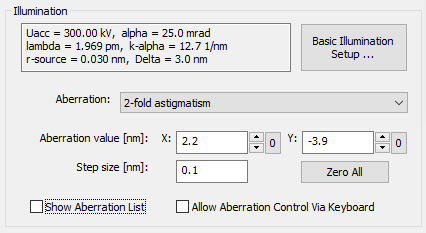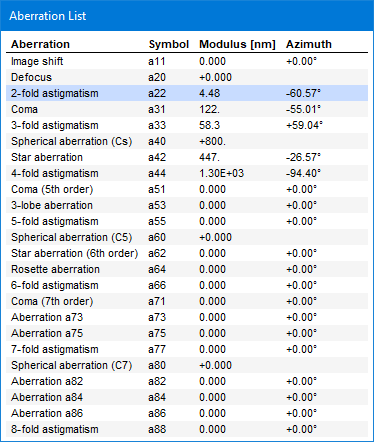|
|
Microscope - Illumination Settings > Dr. Probe / Documentation / GUI / Microscope |

|
The physical parameters describing the probe formation are set in the Illumination section of the Microscope Parameters dialog.

The upper part of this section shows current values of basic illumination parameters such as:
- the accelerating voltage Uacc,
- the radius of the illumination aperture, i.e. the semi angle of probe convergence alpha,
- the electron wavelength lambda,
- the maximum incident beam vector k-alpha in the front-focal plane,
- the effective geometric source radius (HWHM) r-source, and
- the effective defocus spread Delta.
The values of these and some other parameters can be changed via an additional dialog, which opens when you press the button [Basic Illumination Setup].
The lower part of the illumination section concerns the probe aberrations.
Select an aberration from the dropdown list and change its X and Y coefficients by changing the values in the respective edit controls. Type the number or use the spin-control attached to the right side of the edit box. The step size of the spin controls is set in the edit control below. All aberration values are in nanometer units. The probe function display will update each time you change a value.
Pressing the [0] buttons next to the spin controls will set the respective aberration coefficient to zero. All coefficients will be set to zero when you press the [Zero All].
Check Show Aberration List to toggle the display of an extra window which list all aberrations and their current values in polar notation.

Clicking a row in the aberration list window will select the respective aberration as the current aberration for changing its coefficients.
The orientation of aberration coefficients as denoted by the angle in the aberration list window and by the X and Y components are with respect to the simulation axes. These axes are in general not identical to those used in aberration measurements with real microscopes. Before transferring measured aberration coefficients to the simulation, take care to adopt the values to the coordinate system used in the simulation by rotation. This task is usually non-trivial.
Check Allow Aberration Control Via Keyboard to toggle changing aberrations with the arrow keys of your keyboard. Each time you press one of the arrow keys an aberration coefficient is changed with the current step size. Left and right arrow keys change the X-coefficient. Up and down arrow keys change the Y-coefficient of the currently selected aberration. Use the page-up and page-down keys to change the current step size by a factor of ten.
The aberration notation used by Dr. Probe is in principle identical to the notation used by NION, see Krivanek et. al (1999) [1]. For convenience, an aberration list is given below also including the relation to the notation used by CEOS, see Uhlemann & Haider (1998) [2]. Note that some aberration coefficients apply with a different magnitude compared to the CEOS notation, e.g. B2 and S3. All n-fold astigmatism coefficients have a reversed rotational sense, which is denoted by the complex conjugate of the aberration coefficient, e.g. A1, A2.
|
Index |
Aberration (coefficient Dr. Probe) |
Nion [1] |
CEOS [2] |
|
0 |
Image shift (a11) |
C0,1 |
(We) |
|
1 |
Defocus (a20) |
C1,0 |
C1 |
|
2 |
Twofold astigmatism (a22) |
C1,2 |
A1 |
|
3 |
Coma (a31) |
C2,1 |
3·B2 |
|
4 |
Threefold astigmatism (a33) |
C2,3 |
A2 |
|
5 |
Spherical aberration (a40) |
C3,0 |
C3 |
|
6 |
Star aberration (a42) |
C3,2 |
4·S3 |
|
7 |
Fourfold astigmatism (a44) |
C3,4 |
A3 |
|
8 |
Coma (5th order) (a51) |
C4,1 |
5·B4 |
|
9 |
Three-lobe aberration (a53) |
C4,3 |
5·D4 |
|
10 |
Fivefold astigmatism (a55) |
C4,5 |
A4 |
|
11 |
Spherical aberration (6th order) (a60) |
C5,0 |
C5 |
|
12 |
Star aberration (6th order) (a62) |
C5,2 |
6·S5 |
|
13 |
Rosette aberration (a64) |
C5,4 |
6·R5 |
|
14 |
Sixfold astigmatism (a66) |
C5,6 |
A5 |
|
... |
(further in the power-law series) |
... |
... |
|
23 |
Eightfold astigmatism (a88) |
C7,8 |
A7 |
References
- O.L. Krivanek, N. Dellby, A.R. Lupini, Towards sub-Å electron beams. Ultramicroscopy 78 (1999) 1-11 [link] [doi].
- S. Uhlemann, M. Haider, Residual wave aberrations in the first spherical aberration corrected transmission electron microscope. Ultramicroscopy 72 (1998) 1009-119 [link] [doi].
Last update: Jan 26, 2019 contact disclaimer(de)